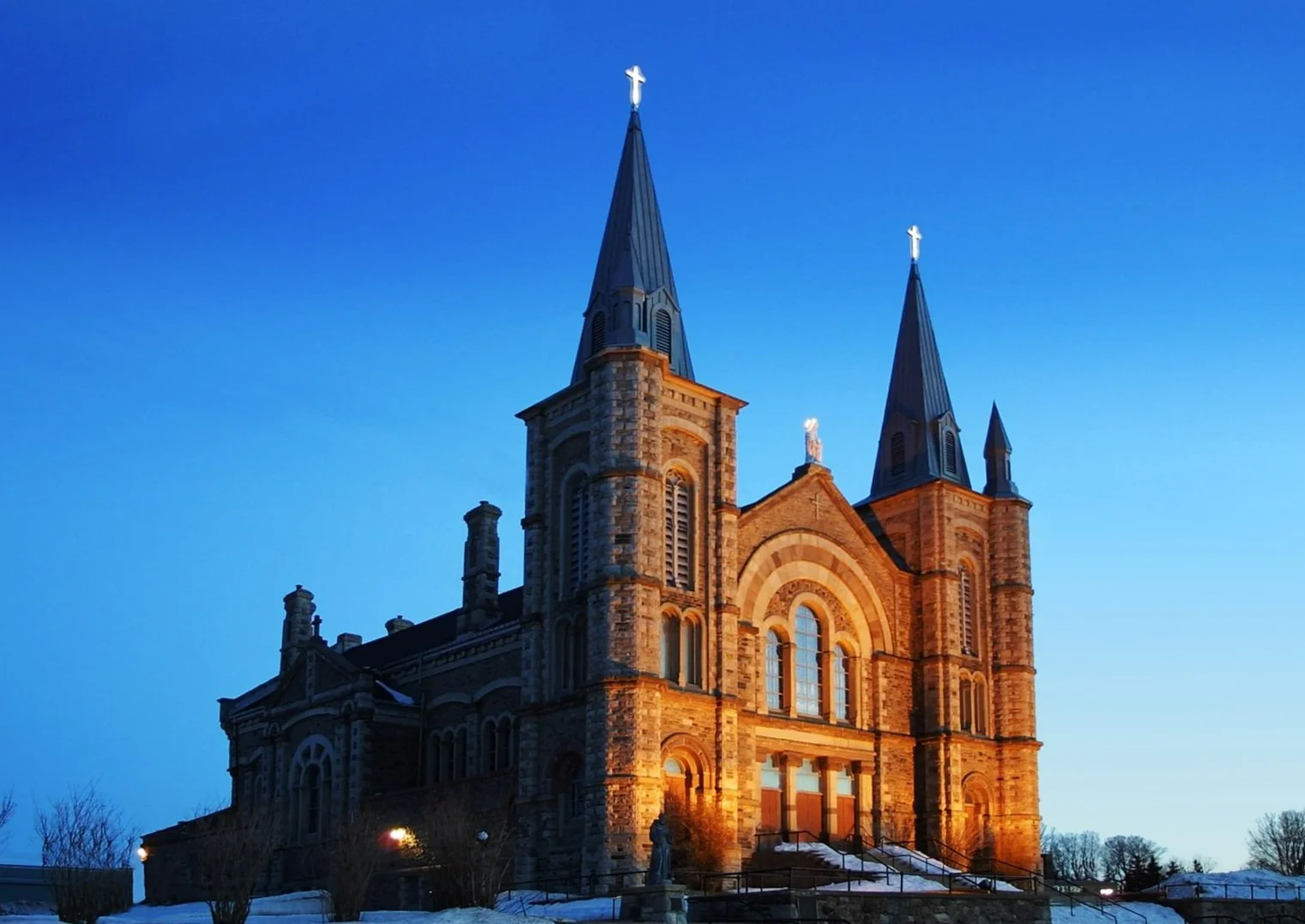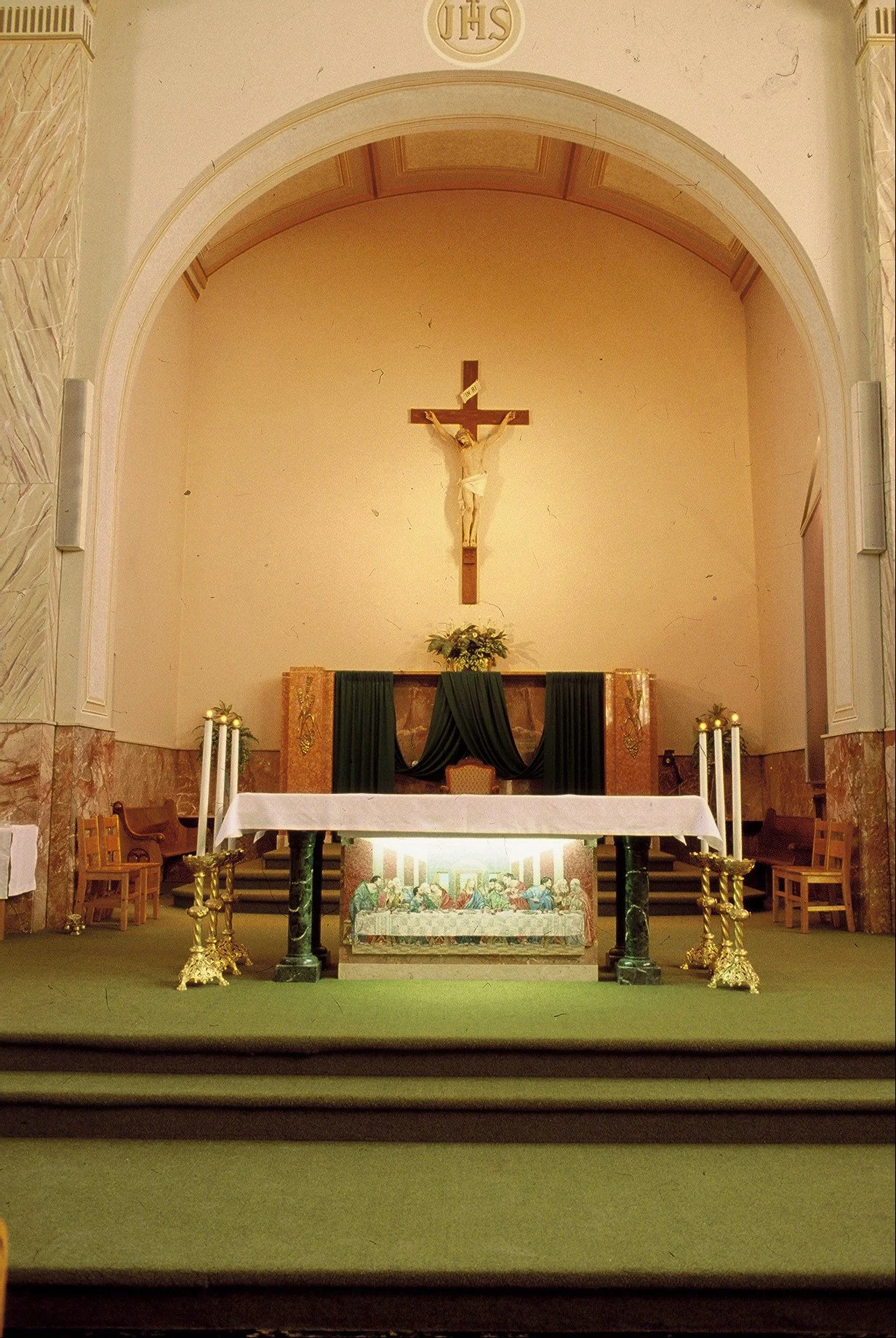The Beauty and Forgotten Heritage that is St. Anne’s Jesuit Memorial Church: Canada’s National Shrine
St. Anne’s Jesuit Memorial Church: Canadian National Shrine. One of the most beautiful churches, inside and out, in all of Canada. Photo by Mike Odesse.
It is early morning on Georgian Bay and the bells sound out over the town and area, signaling the eight a.m. start of another day. Located high in the majestic spires of this, “Cathedral of the North,” the three giant bells cast in France, echo a grander, historic time, a time when this church was significant, and a National Shrine.
One bell is named, “Theophile Pius” dedicated to this shrine’s builder, Theophile Laboureau. The second bell is named “Jean Patrick” after Jesuit missionary, Jean de Brebeuf, and the third bell named “Gabriel Henri” after Jesuit missionary Gabriel Lalement, two of eight martyrs to which this church is dedicated.
Just as they have for 114 years, since their blessing and installation in 1909, seven years after this church was first consecrated and opened, they’ve been a ringing reminder to the locals that their church is still here. Bur sadly, its significance seems to have been forgotten.
When St. Anne’s first log church was constructed in 1832, it was the center of a local but large Catholic universe. St. Anne’s parish stretched from Manitoulin Island in the west, to Orillia and Barrie in the east to Owen Sound in the south and its various mission communities in between. To say that priests from St. Anne’s travelled a lot by horse would be an understatement.
Father Theophile Laboureau, the man who engineered, fundraised and built the present St. Anne’s Jesuit Memorial Church. Many considered him a saint.
A new pastor arrived in Penetanguishene in 1873 and Father Theophile Pius Francis Laboureau soon realized that his little wood-sided church, the second St. Anne’s, was too small to accommodate his growing parish. He amazingly decided to replace it with a grand structure, a large shrine dedicated to the Canadian missionaries who had laboured and were martyred here in his parish in the 1600s.
Laboureau miraculously galvanized not only the locals, but Canadians and the world at large, to raise the necessary funds. Armed with a concept and supporting letters from Prime Minister Sir John A. MacDonald, various premiers, dignitaries and a long list of Canadian Catholic bishops, Laboureau secured hundreds of private donations along with funds from the Senate of France and the Congress of the United States. He also secured funds and blessings from church leaders throughout Europe and the Vatican. Also while in France, Laboureau had an architect from Burgundy draw up rough plans. He chose a Romanesque style of architecture reminiscent of many European basilicas constructed between A.D 800-1270.
Upon his return, his building committee was chosen from all walks of Penetanguishene businesses. He then had famed architect, Thomas Kennedy from Barrie, draw up the construction plans. The exact site on the hill was chosen and the foundation staked and poured for the magnificent structure.
On September 5, 1886, a huge crowd of over 5,000 people from the town, area and throughout Ontario, watched Archbishop of Toronto, J.J. Lynch, bless and lay the historic cornerstone. For sixteen long and arduous years, construction continued on this massive church.
The foundation was built of hand cut Quarry-Island stone, and the three-foot-thick walls composed of coordinated colours of rock-faced granite and fieldstone and trimmed with Credit Valley stone and white Nottawasaga Sandstone. These rough edged stones were often chosen for Romanesque architecture as their richness was enhanced by the shadows caused by the sun. The church was built using local stone masons such as Henry Zoschke, who lived behind Fuller Avenue.
Work could only progress when Father Laboureau secured more funds, an ambitious undertaking for this little town and parish, but he persevered with his dream. The finished church was blessed and opened on December 11, 1902 by the archbishops of Toronto and Kingston and the Bishops of Peterborough and London. Cost was just under $50,000. When Father Laboureau passed away in 1908, his remains were brought back to his beloved Penetanguishene for burial. The day of his funeral, all businesses in the region shut down, to honour this amazing and holy man.
The interior beauty of St. Anne’s, with its amazing stain glass windows, statues and murals, is breathtaking.
Over the ensuing years, various pastors cared for and enhanced his dream. Beautiful stained glass windows, stunning life-like stations of the cross and statues of deBrebeuf and Lalement along with magnificent murals were installed. Laboureau intended his church to be a national shrine and in the early years many pilgrimages were indeed hosted here. But eventually, St. Anne’s became more a parish church, overshadowed by the Martyrs Shrine constructed in the 1920s in Midland by the Jesuits and their money.
Majestic spires were added to St. Anne’s in the late 1990s, to lovingly finish the work begun by Father Laboureau. Things had gone full circle, which brings us to today.
Like many parishes in Canada and around the world, St. Anne’s is facing an aging and shrinking congregation and rising costs to operate. Perhaps it was a bad idea to put such a large cathedral in so small a town even if it was historically and spiritually the place to put it. The future of St. Anne’s is in peril, but in a way, it shouldn’t be.
The peace and tranquility of St. Anne’s is to be experienced to be believed.
Whether one is religious or not, step into St. Anne’s. You’ll find a peacefulness and tranquility not found easily in this crazy world, a place that will soothe your soul and lift your spirits. One can easily picture the saintly Fathers Laboureau, deBrebeuf and Lalemant kneeling quietly somewhere in the front, praying in “their” church. St. Anne’s is a place of peace, prayer and favours, just as its builder intended.
Look around as you stand or sit there. You’ll be quickly aware of and overcome by the sheer size, beauty and magnificence of this church, this shrine, inside and out. It should be a place to be discovered by locals and yes pilgrims and tourists. As Father Athol Murray, who orchestrated the angels, said of St. Anne’s... “No community in Canada can boast a church with the beauty and history of yours. I have always felt that the people of the district never contrived to grasp its significance.”
St. Anne’s Jesuit Memorial Church is often called, “The Forgotten Shrine” and “The Cathedral of the North.” Unmatched in interior and exterior beauty, the town and region must promote this jewel overlooking Penetanguishene and its bay.
Penetanguishene has a jewel in its midst and it must take advantage of that beauty and history. Tourism can help the church and celebrate the town. It’s what Father Laboureau intended so long ago. His dream on the hill overlooking beautiful Penetanguishene Bay was magnificent then and it still is. Its a special place. That’s why I put it in my Seven Keys of Hildegard series.
As the large plaque in front of St. Anne’s unveiled in 1902 said and we must never forget:
“The Jesuit Memorial Church, Canadian National Shrine.”
The large and impressive plaque of contributors, a veritable who’s who in the world in 1902, in front of St. Anne’s.
David Dupuis, is an award-winning author, and the author of, “St. Anne’s of Penetanguishene: Huronia’s First Mission.”





